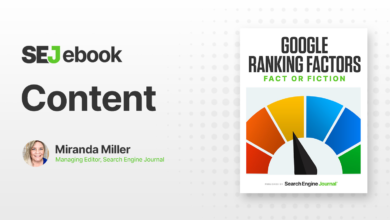10 Creative Whitepaper Ideas To Score Big With Your B2B Audience

White papers are among the best lead generation tools for B2B marketers, but they must provide unique information to ensure that information is shared.
After all, a lead gives up their name, contact, and demographic data to get a free asset.
This is enough to deter a lead from bouncing if your landing page doesn’t provide enough value.
Wikipedia B2B white papers are defined as:
“…papers (which) use selected facts and reasoned arguments to build a favorable case for the company sponsoring the document.”
To me, this is a fair definition because white papers not only inform the audience but also present their brand positively.
They are editorial content that tells opinions, not unlike a newspaper opinion piece or even a sponsored article.
The main difference in the white paper is that it must convey power with the depth of its research—and it must be valuable enough to convert that lead.
In this article, you’ll find 10 creative white paper concepts that will stand out in your social media feeds, email newsletters, and programmatic ads so you can score big with your B2B audience.
1. Evidence written by a C-Suite member
Using this idea, you can combine thought leadership with the level of detail required in a white paper to form opinions in your niche.
Rather than an anonymous document, it was authored by a C-suite member, such as a Chief Executive Officer (CEO) or Chief Technology Officer (CTO).
These often cover pressing issues in your field.
For busy C-suites, ghostwriting is often a very effective option as long as it captures the right tone and ideas.
What makes these white papers stand out is their personal voice, which sparks communication and conveys confidence.
Include the author’s contact information in the footer so that readers can easily communicate their ideas or feedback.
2. White paper with survey results
Polling your audience is a great way to cater to their interests.
After all, people in your industry want to know what other decision-makers in their field think, so they often crave reliable data from surveys.
You can conduct a survey on your own (or hire a survey provider) to gain insights from your audience.
This can be buyer behavior, industry expectations, or even top challenges and ideas on how to address them.
From this data, create a white paper that presents the results but also provides feedback by experts on these ideas and what they mean for your industry.
This type of content positions your brand as an authority, which in turn will act as a major magnet for prospects who trust the quality you bring to the table.
3. Forecasts for the next quarter (or fiscal year)
When a new quarter looms, marketing and sales teams are under pressure to strategize how to improve (or restore) their pipeline productivity.
Thus, a technical document containing forecasts provides valuable guidance for these professionals to formulate their strategies.
These predictions can be backed up by data on trends, hashtags, and even interviews with decision makers across the industry about what they can expect for the months ahead.
4. Insights from academic research
Academics around the world publish valuable research for your audience that you can leverage to create groundbreaking and trusted content.
All it takes is checking out scholarly paper websites like JSTOR and Elsevier Using keywords that relate to your niche.
And if you want to go local, contact your regional university to do research to fuel your ideas for white papers.
Just don’t forget to give credit to the authors. If they wish, they can be featured in a video or webinar later, which in turn will enhance the value and credibility of your ideas.
5. White sheets “Antihiro”
If there is any rule that is held as the gold standard in your niche, yet you believe it has room for improvement (or is just plain wrong), you have the perfect opportunity to publish an “anti-heroes” white paper.
that against the hero It defies conventions–and in this case, a white paper with shocking ideas that will invite readers to consider new possibilities.
However, be careful, because these bold pieces of content can flop if you wrongly challenge respected concepts.
Make sure you back up your arguments with enough evidence as to why certain rules are broken and, if successful, will open a path to new practices in your field (or at least valuable discussion).
Bonus points if your counter white paper turns into viral content promoting your personal brand or that of your business.
6. Forgotten Lessons
Historical figures are often forgotten because their legacy is taken for granted or transcended by the more contemporary modern visions.
If you have any books by classic thinkers that serve as perfect comparisons of how your company is shaped today, you can present their ideas as “forgotten lessons” to your readers in a form of thought leadership.
For example, when it comes to technology, pioneers wrote like Tim Berners-Lee (the English computer scientist best known as the inventor of the World Wide Web) provides insights into how the Internet is used today or at least, an interesting read.
7. Professional reference guide
The Reference Guide is a comprehensive go-to resource for the professional to quickly find what they need for their jobs.
It should cover the basics and contain a brief overview of advanced tasks for a role with links to further reading.
Reference guides typically include an introduction for beginners, a description of the main tasks the job requires, brief questions and answers, and resource recommendations for professional development (books, courses, certifications).
This type of white paper is hard to come by, yet it will likely be an invaluable asset to your audience, especially those who are just starting their careers.
for example , “The Pocket Book for the Mechanical EngineerIt is a comprehensive guide for beginners and senior engineers to consult symbols, formulas, reference diagrams, and components.
The book has been revised three times since its publication in 1990 to keep up with the latest technology.
However, its structure has remained the same, which proves how easily this type of content can be updated to remain relevant.
8. Brief report on the case study
If you have related case studies, why not bring them together in one white paper?
5 case studies from [Product] For SMEs in the healthcare field is a hypothetical example in which you provide a summary of each case study with an overview of the overall findings.
This allows your case studies to pack in more information and is an easy white paper to produce if you already have the original content available.
9. Lessons from previous directions
This white paper idea was also inspired by lessons from the previous year.
However, it relies on insights from trends rather than the ideas of industry leaders.
While trends can be said to be unpredictable, the common element these white papers share is a fresh and unexpected perspective for the public.
In other words, direction cuts through noise.
So, if you put together past trends in your niche, you will understand why they are so highly valued and distinguished by your audience.
You can publish what you’ve learned in a white paper like “7 Lessons from the Biggest Hospitality Trends of 2020,” for example.
10. Joint Marketing Worksheets
With co-marketing, you partner with another company to launch an asset and share the leads generated.
Partnering with a trusted brand can not only raise the perceived value of your services, but also reduce the workload of your team.
If, for example, you want to launch a white paper on educational technology, why not market share with a brand that has different (but not competitive) offerings?
With co-marketing, you can double your reach as well, publishing your asset on more frictionless channels and taking advantage of separate paid media budgets.
Thus, it is a win-win, allowing marketing teams to select the most qualified leads from their company’s own campaign.
Final considerations
Oftentimes, simply choosing the right white paper idea is not enough.
To ensure it’s also an engaging lead generation tool, here are four additional considerations:
Be concise, but don’t skimp on the content
Your audience will read your white paper precisely for its in-depth knowledge, but that doesn’t mean thinking about unnecessary information.
Nor does it mean forwarding an article to a multi-page PDF file just so it can generate leads.
White papers are not supposed to be as resource-dense as scholarly papers, but rather long reports on an interesting topic.
It may be a problem-solving tool (such as a reference guide) or it can simply display results.
What you should keep in mind when creating a white paper is readability, which can be improved by displaying summaries, indexes, subsections, and lists.
Include as much information as the reader needs to understand the topic.
Stay in touch with your organization’s leadership team
Whether you’re a freelancer or an in-house content writer, speaking with your leaders (or clients) is a must for crafting thought leadership content that will appeal to your audience.
It also helps spark creativity, which is often necessary to produce the ground-breaking content needed for a noteworthy discussion.
This way, leaders can better anticipate needs in the marketplace, rather than creating content based solely on what has worked in the past according to CRM and SEO metrics.
Don’t copy what’s already there
If you read a competitor’s white paper and think, “Wow, we can do this,” don’t!
Many companies fall into the trap of copying other brands, polluting the world of information with duplicate content.
Instead, analyze what makes this content good and what features apply to your brand.
Then, you’ll be ready to create fresh, informed white papers that can outperform your competitors’ success.
Challenge agreements
Like the antihero white paper idea from this list, making an unexpected proposal can make your white paper stand out.
Maintaining this perspective prevents you from posting mundane content because you will be creatively questioning the reasoning behind the industry status quo.
Keep in mind that rebellion works best, so don’t unnecessarily support this aspect of your work.
More resources:
- Should I write content for people or for search engines?
- 100 Types of Content: The Ultimate Guide for Marketers
- Content Marketing: The Ultimate Beginner’s Guide to What Works
Featured image: SkyPics Studio / Shutterstock

![7 Ad Copy Tests To Boost PPC Performance [With Examples]](https://altwhed.com/wp-content/uploads/2023/01/1672844873_7-Ad-Copy-Tests-To-Boost-PPC-Performance-With-Examples-390x220.png)

![TLD Experimentation & Authority Building with Publishing and SEO [Podcast]](https://altwhed.com/wp-content/uploads/2023/01/TLD-Experimentation-Authority-Building-with-Publishing-and-SEO-Podcast-390x220.jpg)
